In the article, we will consider the removal of the brake drum, the replacement of the pads and the replacement of the brake slave cylinder.
Removing and inspecting the brake drum
We change the brake drum at the maximum allowable wear with a 1.4 liter engine - 181.25 mm, and with a 1.6 liter engine - 204.45 mm.
Also, the brake drum is removed for inspection and replacement of the brake pads, slave cylinder and replacement of the parking brake cable.
We install the car on a lift or jack up the back of the car and put it on supports.

With a chisel, carefully press the protective cap out of the hub

Remove the protective cap
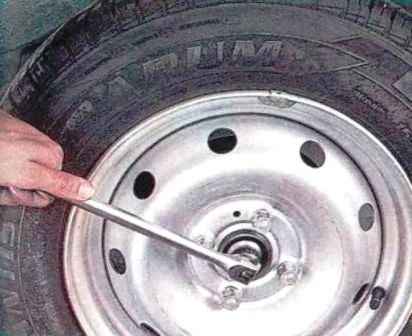
Loosen the hub nut and wheel bolts.
Hang out the back of the car and put it on supports.
Remove the rear wheel.
Check that the parking brake lever is down.

Unscrew the nut of the rear wheel hub
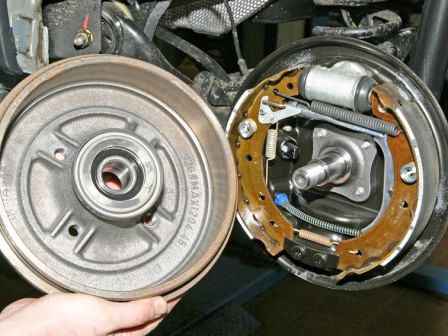
Remove the brake drum together with the bearing from the hub trunnion.
The brake drum is made in one piece with the hub
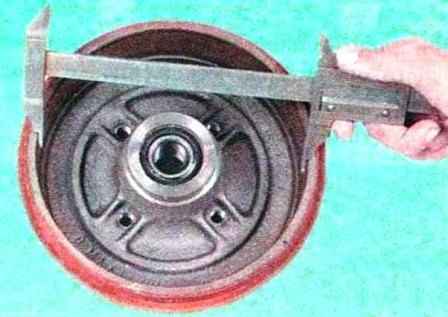
We measure the diameter of the working surface with a caliper. If the diameter exceeds the maximum allowable, then the drum is replaced.
We check the ease of rotation and the absence of play in the hub bearing.
If we install the old drum, use a file to remove the shoulder on the working surface of the drum, formed as a result of wear.
We reset the gap adjuster as described below.
We reduce the brake pads with two mounting blades.
Installing the drum. Tighten the hub nut to a torque of 175 Nm
We press the brake pedal 10-15 times to adjust the gap between the pads and the drum.
You should hear the knob click each time you press it. As soon as the clicks stop, the gap is set.
Install the wheel and check the ease of rotation of the wheel. Light touching of the pads on the drum is allowed.
Replacing the brake pads of the rear wheels
We replace pads if:
- - the surface of the overlays is heavily oiled;
- - friction linings are loosely connected to the pad base;
- - overlays have deep grooves and chips;
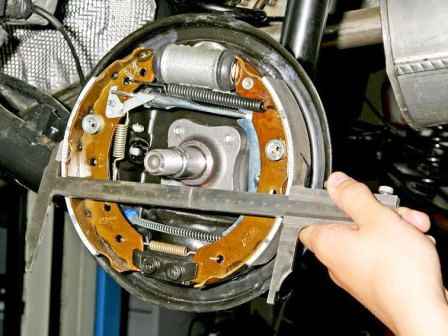
- - the thickness of the friction linings is less than 179.4 mm for cars with a 1.4 l engine and 202.45 mm for cars with a 1.6 l engine.
To work, you will need a wheel wrench, pliers, sliding pliers and screwdrivers.
We install the car on a lift or jack up the back of the car and set it on stops.
The parking brake lever must be fully depressed.
Remove the wheel
Remove the brake drum as described above
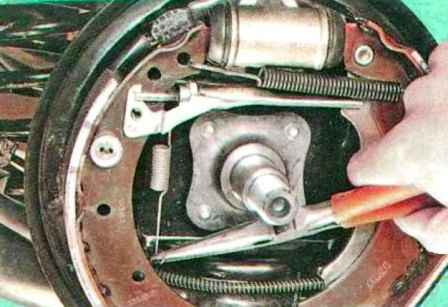
Disconnect the spring of the clearance adjuster lever from the front shoe

Removing the springinu by disconnecting its other end from the regulator lever

Remove the clearance adjuster lever
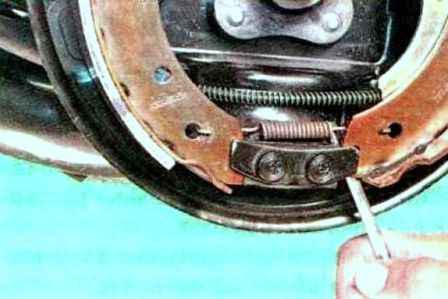
We pry off the lower retaining spring of the pads and remove it from the hole in the rear brake pad
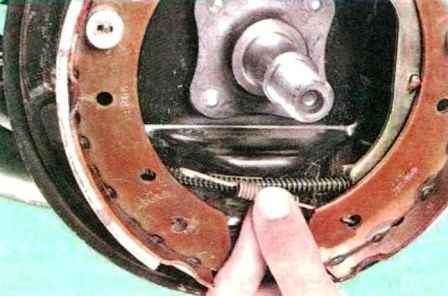
Retrieve the spring
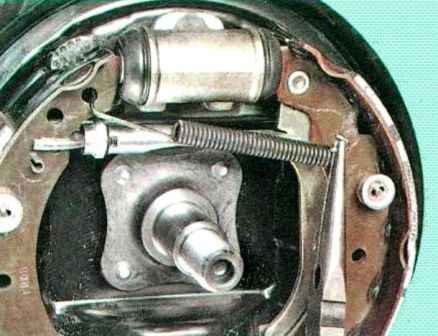
We unhook the bent end of the upper coupling spring from the rear block with pliers

By turning the other end of the spring in the hole of the front shoe, remove the spring

Slightly move the front shoe forward

Holding the rear shoe, remove the gap adjuster together with the spacer bar by turning the bar 90˚ along the axis.
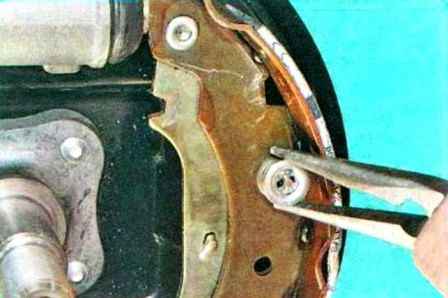
Holding the support post, press on the clamping spring mounting cup, turn it a quarter of a turn
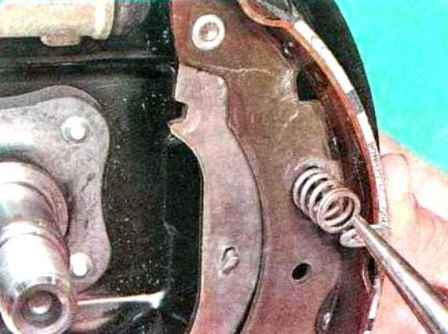
Remove the cup and spring, as well as the support post
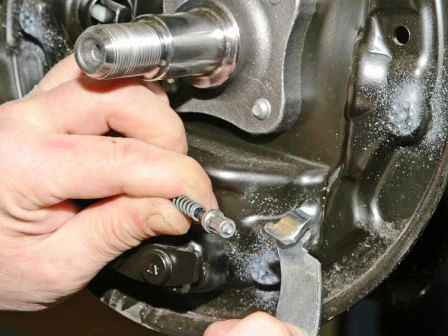
We remove the rear shoe from the brake shield, disconnect the expansion lever from the parking brake cable, pressing its spring with pliers, and remove the shoe
Remove the pressure spring and the front shoe support post in the same way as we did for the rear shoe and remove the front shoe
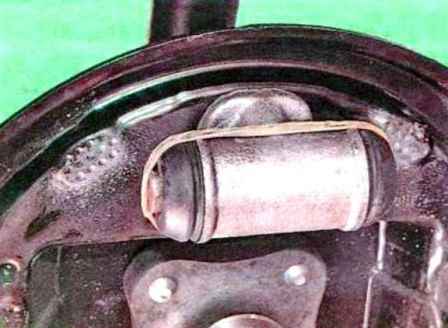
After removing the pads, we fix the pistons of the working cylinder in any way possible so that the pistons do not fly out of the cylinder
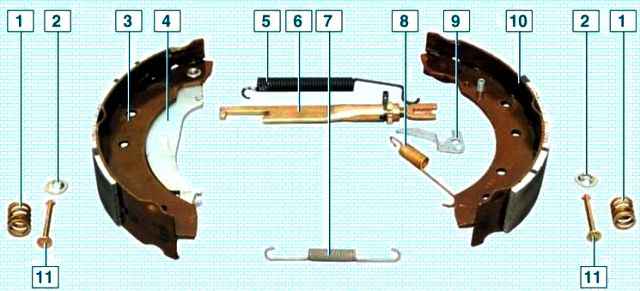
Cleaning and inspecting the parts of the brake mechanism
The details of the spacer bar and adjuster of the gaps of the left brake mechanism and the right brake mechanism are not the same.
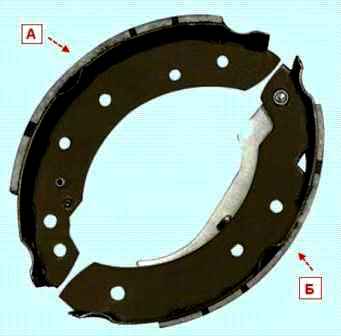
The front "A" and the back "B" pads are different in design.
Besides this, torm The pads are different for both left and right.
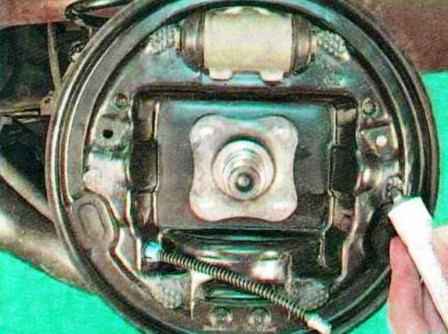
We apply refractory grease for brake mechanisms to the friction points of the front and rear brake pads on the brake shield

We also lubricate the thread of the rod "A" of the spacer bar and screw the nut "B" to the end, but do not tighten it.
It is better, of course, to replace the adjusting bars together with the gap adjusters.
We release the pistons of the working cylinder from the fixing device, and with sliding pliers we compress the pistons of the working cylinder.
Install the pads in reverse order.
Installing the brake drum
We adjust the gap between the brake drum and the pads by pressing the brake pedal ten to fifteen times.
You should hear the knob click each time you press it. As soon as the clicks stop, the gap is set.
In the same way, we change the pads on the second wheel.
After installing the brake pads, adjust the parking brake.
Replacing the working cylinder of the rear wheel brakes
A sign of a malfunction of the brake cylinder is drips on the inside of the wheel, as well as the lack of braking of one of the rear wheels due to jamming of the pistons of the brake cylinder.
To remove the brake cylinder, you need tools: a wrench for wheel bolts, a wrench for 10, a special wrench for brake pipes for 11.
We prepare the car for the task, remove the corresponding wheel

We clean the places where the brake cylinder is attached from dirt
Remove the brake drum as described at the beginning of the article
Raise the parking brake lever so that the upper ends of the shoes move away from the pistons of the working cylinder
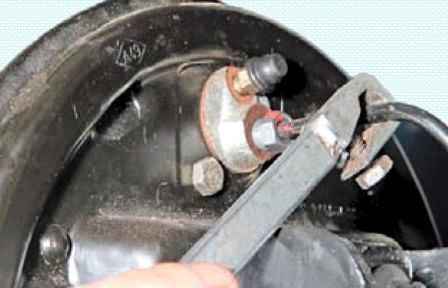
Unscrew the nut securing the brake pipe to the working cylinder

We muffle the opening of the brake pipe with a cap from the air release valve
If the tube nut does not loosen well or does not loosen at all.
First, you need to unscrew the cylinder mounting bolts, then push the cylinder inward and, holding the tube nut with the cylinder wrench, unscrew it from the nut.
After that, you can restore the mobility of the nut by moistening it with brake fluid and turning the nut in both directions.

We unscrew the two bolts of the working cylinder
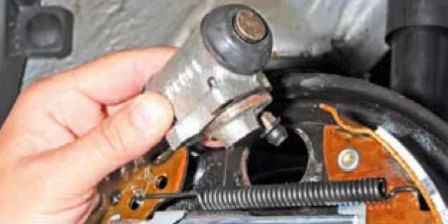
Remove the working cylinder.
Install the cylinder in reverse order.
Bleeding the brake system (article - Replacing brake fluid and pumping the brakes Renault Sandero).
We press the brake pedal several times to bring the brake pads to the drum.





